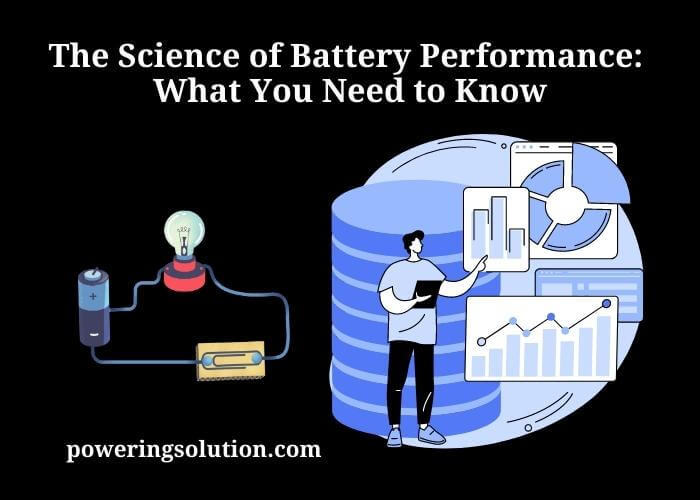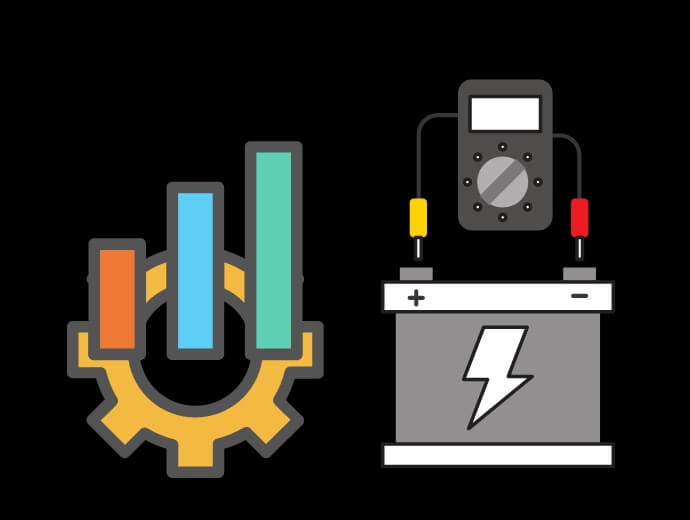Published on: February 16, 2023
Written by Ian Carter / Fact-checked by Baten Khalil
In today’s fast-paced world, batteries are an essential component of modern society. From powering up our smartphones, laptops, and other portable devices to providing energy for electric cars and renewable energy storage, batteries play a critical role in our daily lives. But have you ever wondered how they work and what factors affect their performance?

This article will explore the science of battery performance, from the fundamental principles of how batteries work to the latest innovations in battery technology. We’ll delve into the key factors that impact battery performance, including temperature, humidity, age, overcharging, and depth of discharge. We’ll also discuss how battery performance is tested and measured, and highlight some of the current and upcoming advancements in battery technology.
Whether you’re a tech enthusiast or just curious about the science behind batteries, this article will provide a comprehensive overview of battery performance that will leave you with a deeper understanding of how these energy storage devices power our lives.
Fundamentals of Batteries
At their most basic level, batteries are devices that convert chemical energy into electrical energy. This process occurs through a series of chemical reactions that take place inside the battery’s cells. Each cell consists of two electrodes (a cathode and an anode) separated by an electrolyte, which allows ions to flow between the electrodes.
When a battery is connected to a circuit, a chemical reaction occurs at the anode that causes it to release electrons. These electrons then flow through the circuit, powering whatever device the battery is connected to. At the same time, a complementary chemical reaction takes place at the cathode that absorbs these electrons.
The key components of a battery include the anode, cathode, electrolyte, and separator. The anode is typically made of a metal or alloy, while the cathode is made of a different material that can react with the anode to produce an electrical potential. The electrolyte is a substance that allows ions to flow between the electrodes, while the separator keeps the electrodes apart and prevents them from coming into contact.
There are many different types of batteries, each with its unique properties and applications. Some of the most common types of batteries include lead-acid batteries, nickel-cadmium (NiCad) batteries, nickel-metal hydride (NiMH) batteries, lithium-ion (Li-ion) batteries, and alkaline batteries. These different types of batteries vary in terms of their energy density, voltage, capacity, and rechargeability, among other factors.
Understanding the fundamentals of batteries is essential for understanding how they work and how to select the right battery for a given application. By knowing the basic components and principles of battery technology, you can better appreciate the complex science behind these essential energy storage devices.
Factors Affecting Battery Performance
While batteries are designed to provide long-lasting and reliable power, several factors can impact their performance over time. Understanding these factors can help you maximize the lifespan of your batteries and ensure that they operate at peak efficiency.
Temperature
Temperature is one of the most significant factors affecting battery performance. Extreme temperatures, whether hot or cold, can reduce a battery’s capacity and lifespan. High temperatures can cause batteries to degrade more quickly, while low temperatures can reduce a battery’s ability to provide energy.
Humidity
High levels of humidity can also impact battery performance. Moisture can corrode battery terminals and lead to reduced conductivity and power output.
Age
Like all devices, batteries age over time, and their performance can deteriorate. The chemistry inside the battery changes over time, leading to a decrease in capacity and energy output.
Overcharging
Overcharging a battery can damage it and reduce its lifespan. This occurs when a battery is left on charge for too long, causing it to overheat and damaging its internal chemistry.
Depth of Discharge
The depth of discharge refers to how much energy is drawn from the battery before it is recharged. Deep discharges can lead to irreversible damage to the battery, reducing its capacity and lifespan.
Storing batteries in a cool and dry place, avoiding overcharging, and using a battery at a moderate depth of discharge can all help to extend its life and maintain its efficiency.
Testing and Measuring Battery Performance
To determine the performance of a battery, several parameters are typically measured. These include capacity, voltage, and internal resistance.

| Capacity | Capacity refers to the total amount of energy that a battery can store and provide. It is usually measured in ampere-hours (Ah) or milliampere-hours (mAh) and can be calculated by multiplying the current output by the time that the battery can provide that output. |
| Voltage | Voltage is a measure of the electrical potential difference between the battery’s two electrodes. It is usually measured in volts (V) and can indicate the current state of charge of the battery. |
| Internal Resistance | Internal resistance refers to the resistance to the flow of current inside the battery. Higher internal resistance can lead to lower capacity and reduced performance. |
Batteries can also be tested for their cycle life, which refers to the number of charge and discharge cycles that the battery can undergo before its performance begins to degrade. This is an important metric for rechargeable batteries and can help determine the battery’s overall lifespan and durability.
There are several methods for testing and measuring battery performance, including constant current discharge, pulse discharge, and impedance spectroscopy. These tests can provide detailed information about a battery’s performance, including its capacity, voltage, and internal resistance.
Battery performance is typically tested under controlled conditions, with standardized temperature and humidity levels. This ensures that the results are accurate and comparable across different batteries and testing conditions.
By understanding the methods and parameters used to test battery performance, you can better evaluate the performance of different batteries and select the best option for your needs.
Innovations in Battery Technology
Advances in battery technology have made significant strides in recent years, with new and improved battery chemistries, designs, and manufacturing processes.
- Lithium-Ion Batteries: Lithium-ion batteries are currently the most widely used rechargeable battery in electronic devices. These batteries use lithium ions to transfer energy between electrodes and have a high energy density, low self-discharge rates, and a long lifespan.
- Solid-State Batteries: Solid-state batteries use a solid electrolyte instead of a liquid electrolyte, providing higher energy density, faster charging times, and improved safety compared to traditional lithium-ion batteries.
- Sodium-Ion Batteries: Sodium-ion batteries use sodium ions instead of lithium ions and have the potential to offer a cheaper and more sustainable alternative to lithium-ion batteries.
- Zinc-Air Batteries: Zinc-air batteries use zinc and oxygen as reactants and can provide a high energy density, making them ideal for use in electric vehicles and other applications that require long-lasting power.
- Flow Batteries: Flow batteries use two liquid electrolytes separated by a membrane, allowing them to store large amounts of energy and discharge it over an extended period. This makes them ideal for use in large-scale energy storage applications.
- Self-Healing Batteries: Self-healing batteries use a gel electrolyte that can automatically repair any damage to the battery, reducing the risk of failure and increasing the battery’s lifespan.
With these innovations in battery chemistry, there have also been advancements in battery manufacturing processes and designs, such as 3D printing, which allows for the creation of complex and customized battery shapes.
These innovations in battery technology have the potential to revolutionize the way we use and store energy, offering improved performance, longer lifespans, and more sustainable and cost-effective solutions.
Conclusion
The science of battery performance is a complex and evolving field, with numerous factors affecting the performance of different battery types. By understanding the fundamentals of battery operation, the factors that affect battery performance, and the methods used to test and measure battery performance, you can better evaluate different battery options and select the best choice for your needs.
Understanding the existing battery technologies, it is also important to stay up-to-date with the latest innovations in battery chemistry, manufacturing processes, and designs. These innovations have the potential to revolutionize the energy industry, providing more sustainable and cost-effective solutions for energy storage and usage.
As we continue to rely more heavily on battery-powered devices and renewable energy sources, the importance of battery performance will only continue to grow.
Common Questions & Response
How Can User-Friendly Software Enhance Battery Performance Management?
User-friendly energy management software can enhance battery performance management by providing easy access to data, real-time monitoring, and efficient control of energy usage. With intuitive interfaces and customizable features, users can optimize energy consumption, extend battery life, and reduce energy costs in a hassle-free manner.
What is the Most Important Factor Affecting Battery Performance?
Several factors can affect battery performance, but one of the most important is the battery’s internal resistance. Higher internal resistance can lead to lower capacity and reduced performance.
How Does the Chemistry of LFP Batteries Affect Their Performance Compared to Other Types of Batteries?
When it comes to battery performance, understanding the chemistry of LFP batteries is crucial. The A to Z information on LFP reveals that their unique lithium iron phosphate composition allows for longer lifespan, higher energy density, and improved safety compared to other types of batteries.
How Can I Extend the Lifespan of My Battery?
There are several steps you can take to extend the lifespan of your battery, such as avoiding extreme temperatures, avoiding deep discharges, and using the correct charging method.
Does Recharging Affect the Performance of Batteries?
The battery recharging process can affect the performance of batteries over time. As you recharge a battery, its capacity may decrease, leading to shorter running times. It’s important to follow proper charging guidelines to maintain the longevity and effectiveness of the battery.
How Do I Determine Which Battery is the Best Option for My Needs?
The best battery for your needs will depend on several factors, including the device or application you are using, the required performance specifications, and your budget. It is important to consider the battery’s capacity, voltage, internal resistance, and cycle life when evaluating different options.

